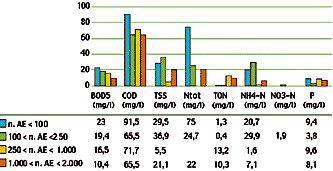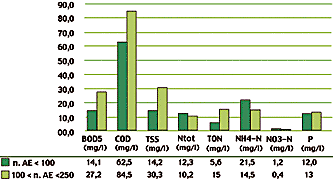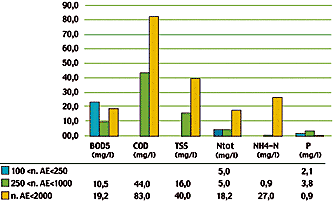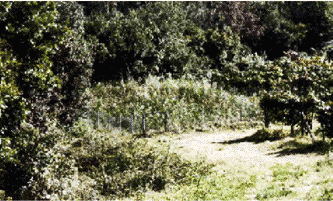Constructed wetlands, natural water purification systems
Results
The choice of system to use depends on the purification needs of the effluent or waste water. Generally the SFS-h systems are used for removing biologically and chemically biodegradable material and suspended solids; they have a removal efficiency on the order of 90 percent for those contaminants.
Multi-state systems are used with increasing frequency in order to provide increased breakdown of contaminants and thus optimise the performances of natural purification systems.
The typical layout of a multi-stage system is shown in the following diagram:

PRIMARY TREATMENT
Imhoff tank as a sedimenter for eliminating the coarsest parts of the waste water;
SECONDARY TREATMENT
Horizontal subsurface flow system (SFS-h) for breaking down most organic matter and suspended solids emerging after the primary treatment;
TERTIARY TREATMENT
Surface free flow system (FWS) for perfecting purification (especially denitrifying) and collecting the purified outflow.



System allowing water reuse.
Operational aspects
As described above, thanks to their simplicity to build and maintain, the systems are particularly appropriate for small and medium-sized communities and rural environments. There is no need for specialised labour to manage the operational aspects the systems require.
The most important aspects concern the regular draining of the septic tank, placed upstream from the phytopurification system, and the control of the water level in the bed (serves also to prevent the growth of weeds) and the condition of the vegetation.
The only maintenance of the plants involves seeing that they grow normally and providing periodic manual clearing of vegetation, normally every two/three years; the process seems to revitalise the plants and stimulate stronger and more uniform new growth.
The FWS system requires even less operational management, as the system is designed to evolve in the most natural manner possible. Mowing or scything every three years is expected.
Controlling the water level consists fundamentally in the following:
- keeping the roots and rhizomes of the hydrophites in contact with the water;
- preventing the growth of invasive weeds that tend to take over, especially in non-saturated areas of the bed during the first few months the system is operating.

Horizontal subsurface flow system (Siena, Italy)
Advantages
In addition to the advantages already mentioned, Constructed Wetlands make it possible to:
- recover nutrients that would otherwise have a negative environmental impact;
- promote a recycling logic that encloses the cycle of some nutrients like nitrogen and phosphorous inside the production areas;
- purify waters to reuse them for irrigation purposes; this creates a closed cycle of water usage and leads to significant savings of drinking water supplies which may be set aside for consumption only.
Constructed Wetlands are a solid choice for treating waste waters and are capable of improving the purifying capacities of existing structures, as well as reducing the pollution of waterways and the contamination of water sources.
DOWNLOAD THE BROCHURE PDF
english (1.0 MB)spanish (0.7 MB)
albanian (0.4 MB)








 COUNTRY OF ORIGIN
COUNTRY OF ORIGIN OUTSTANDING IDEASS PROJECTS
OUTSTANDING IDEASS PROJECTS